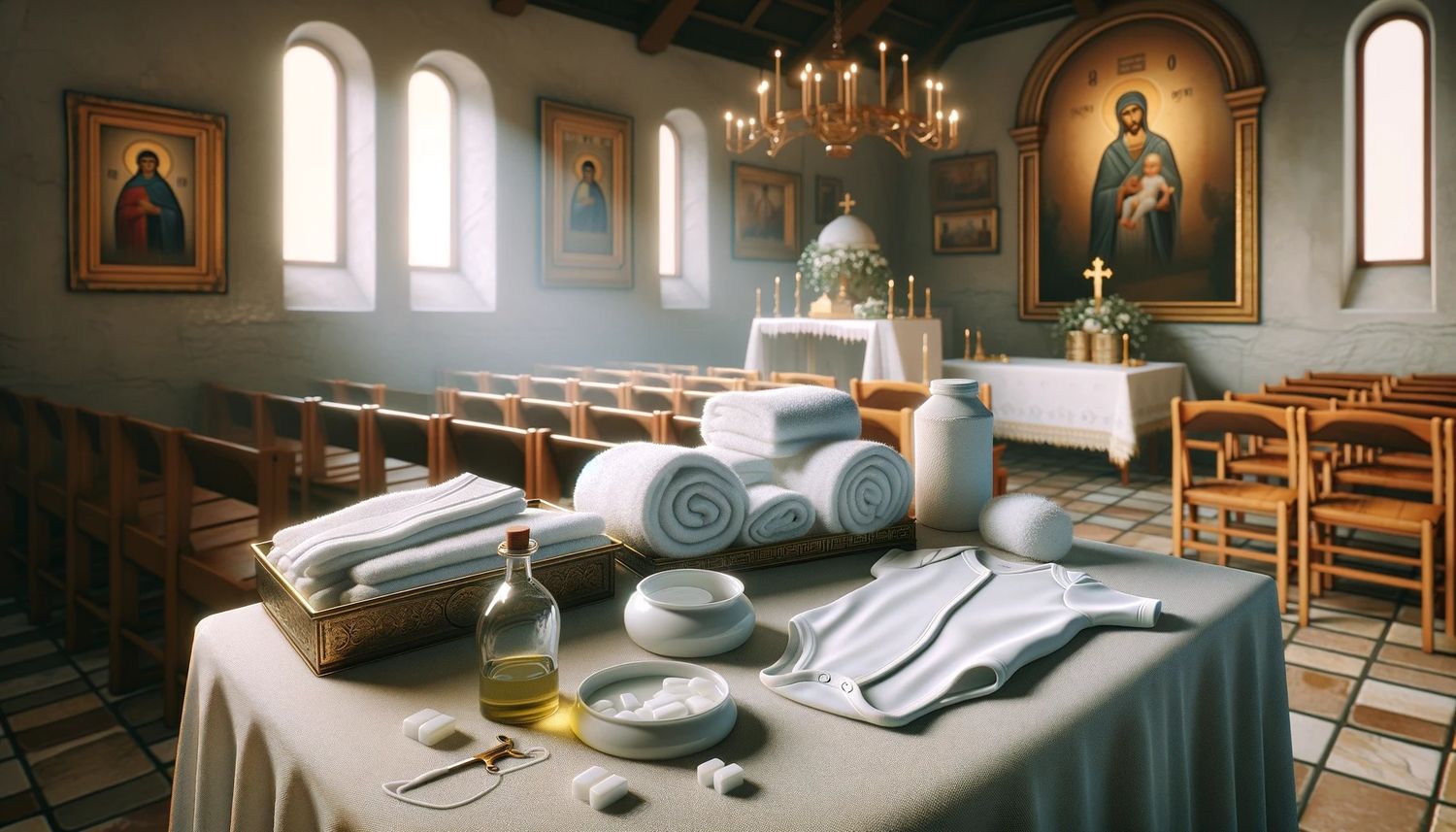Home>Theology and Spirituality>How Long Does A Baptism Ceremony Last?


Theology and Spirituality
How Long Does A Baptism Ceremony Last?
Published: March 1, 2024
Jason DeRose, Managing Editor at Christian.net, uses his expertise in religion and journalism to deepen understanding of faith's societal impacts. His editorial leadership, coupled with a strong academic background, enriches the platform’s diverse content, earning him recognition in both journalism and religious circles.
Discover the duration of a baptism ceremony and its significance in theology and spirituality. Learn about the traditions and customs involved.
(Many of the links in this article redirect to a specific reviewed product. Your purchase of these products through affiliate links helps to generate commission for Christian.net, at no extra cost. Learn more)
Table of Contents
Introduction
How long does a baptism ceremony last? This is a common question for individuals preparing for a baptism, as well as for those attending as guests. The duration of a baptism ceremony can vary based on several factors, including the religious tradition, the specific rituals involved, and the customs of the community where the ceremony takes place. In this article, we will explore the significance of baptism, the preparation involved, the order of the ceremony, variations in ceremony length, and the factors that can affect the duration of a baptism ceremony. Understanding these aspects can provide insight into the diverse practices surrounding this important rite of passage in various religious traditions.
The Significance of Baptism
Baptism holds profound significance in many religious traditions, symbolizing purification, initiation, and the reception of divine grace. It is often viewed as a sacred ritual that marks the beginning of a person's spiritual journey within the faith community. In Christianity, baptism is considered a sacrament, representing the cleansing of sin and the initiation into the body of Christ. It is a public declaration of faith and a symbol of rebirth and new life in Christ. In other religious traditions, such as Hinduism and Sikhism, baptism or similar rites serve as a form of initiation into the community and the religious way of life. The act of immersion in water or the pouring of water over the individual is symbolic of spiritual cleansing and the washing away of impurities, preparing the individual for their new role within the religious community. The significance of baptism extends beyond the individual, as it also serves to strengthen the bonds of the community and reaffirm the collective commitment to the religious tradition.
Preparation for the Baptism Ceremony
-
Spiritual Readiness: Before the baptism ceremony, individuals are encouraged to engage in spiritual preparation. This may involve prayer, reflection, and seeking guidance from religious leaders to ensure that they are spiritually ready to undergo the ritual.
-
Instruction and Education: In many religious traditions, individuals, especially adults, are required to undergo instruction or education about the significance of baptism and its implications for their faith journey. This may involve attending classes or sessions to deepen their understanding of the ceremony.
-
Selection of Godparents or Sponsors: For infant baptisms or in some Christian denominations, the selection of godparents or sponsors is an essential part of the preparation process. Godparents are chosen to support the individual in their spiritual growth and serve as mentors in the faith.
-
Logistical Arrangements: Practical arrangements such as selecting a date for the ceremony, coordinating with the officiating clergy, and making arrangements for the baptismal garment or other ceremonial items are part of the preparation process.
-
Ceremonial Items: Depending on the religious tradition, there may be specific ceremonial items required for the baptism, such as a baptismal gown, candles, anointing oils, or other symbolic elements. Ensuring that these items are prepared in advance is an important aspect of the overall preparation for the ceremony.
-
Community Involvement: In some religious communities, the preparation for a baptism ceremony may involve the active participation of the broader faith community. This could include prayers for the individual, support from fellow congregants, and the involvement of the community in the actual ceremony.
-
Personal Reflection and Commitment: Individuals preparing for baptism often engage in personal reflection and reaffirmation of their commitment to their faith. This may involve examining their beliefs, confessing any sins, and expressing their dedication to living according to the teachings of their religious tradition.
-
Customs and Traditions: Different cultures and religious denominations have their own customs and traditions related to baptism. These may include specific rituals, prayers, or cultural practices that are integrated into the preparation process, adding depth and richness to the overall experience.
By engaging in these preparatory steps, individuals and their families can fully embrace the significance of the baptism ceremony and approach it with reverence and understanding.
The Order of the Baptism Ceremony
-
Welcome and Opening Prayers: The ceremony typically begins with a warm welcome extended to the congregation and the family of the individual being baptized. Opening prayers are offered, invoking blessings and guidance for the proceedings.
-
Reading of Scriptures and Teachings: In many religious traditions, selected scriptures and teachings related to baptism are read aloud. These passages often emphasize the significance of the ritual and the spiritual truths it represents.
-
Renunciation of Sin and Affirmation of Faith: The individual being baptized, or their parents and godparents in the case of infant baptism, publicly renounce sin and affirm their faith in the presence of the congregation. This declaration is a pivotal moment in the ceremony, symbolizing a commitment to the beliefs and values of the faith.
-
Blessing of the Water: The officiating clergy blesses the water that will be used for the baptism. This blessing is a sacred invocation, imbuing the water with spiritual significance and purifying properties.
-
Immersion, Pouring, or Sprinkling: The method of administering the water varies among different religious traditions. Some involve full immersion in water, symbolizing a complete cleansing and rebirth. Others use pouring or sprinkling of water over the individual's head, signifying purification and the bestowal of divine grace.
-
Anointing and Sealing: In certain denominations, anointing with oil and the laying on of hands follow the baptism. This act signifies the sealing of the baptized person with the gifts of the Holy Spirit and the anointing of God's grace upon them.
-
Presentation of the Baptized: The newly baptized individual is presented to the congregation, often accompanied by prayers and blessings. This moment marks their formal entry into the faith community and is celebrated as a joyous occasion.
-
Welcome into the Church: If the individual being baptized is not already a member of the church, they may be formally welcomed into the congregation. This step varies based on the religious tradition and the individual's prior affiliation with the faith community.
-
Prayers for Guidance and Strength: Additional prayers are offered for the baptized person, seeking divine guidance, strength, and protection as they continue their spiritual journey.
-
Closing Blessing and Sending Forth: The ceremony concludes with a closing blessing and words of encouragement. The congregation is often invited to offer their support and love to the newly baptized individual as they embark on their life as a member of the faith community.
By following this structured order, the baptism ceremony unfolds as a meaningful and sacred event, rich in symbolism and spiritual significance.
Variations in Baptism Ceremony Length
The length of a baptism ceremony can vary significantly across different religious traditions and denominations. While some ceremonies may be relatively brief, others can be more elaborate and extended. Here are some factors that contribute to the variations in baptism ceremony length:
Read more: How Long Is A Lutheran Wedding Ceremony
1. Religious Tradition
Different religious traditions have distinct practices and rituals associated with baptism. For example, in some Christian denominations, infant baptisms may be relatively short, involving essential prayers, blessings, and the administration of water. On the other hand, adult baptisms or those in certain Orthodox or Catholic traditions may include additional rites, such as anointing with oil, the lighting of candles, and the recitation of specific prayers, leading to a longer ceremony.
2. Cultural Customs
The cultural context in which the baptism takes place can influence the length of the ceremony. In some cultures, baptism is intertwined with traditional customs and celebrations, which can extend the overall duration of the event. Cultural elements such as music, dance, and communal feasting may be incorporated, adding to the richness and length of the ceremony.
3. Number of Individuals Being Baptized
The number of individuals participating in the baptism can impact the length of the ceremony. In cases where multiple individuals, whether infants, children, or adults, are being baptized together, the proceedings may take longer due to the individual blessings, prayers, and affirmations for each person.
4. Inclusion of Additional Rites
Certain religious traditions include supplementary rites within the baptism ceremony, such as the bestowal of specific blessings, the exchange of vows, or the participation of sponsors or godparents. These additional elements contribute to a more extended and comprehensive ceremony.
Read more: How Does A Baptism Work
5. Liturgical Season and Calendar
The liturgical calendar and the season in which the baptism occurs can also influence the length of the ceremony. For example, baptisms during major religious festivals or significant liturgical seasons may incorporate special readings, hymns, and prayers related to the occasion, lengthening the overall duration of the ceremony.
6. Clergy and Officiating Practices
The practices and preferences of the officiating clergy can impact the length of the baptism ceremony. Some clergy members may choose to include personal reflections, teachings, or exhortations, while others may adhere to a more streamlined and succinct format, affecting the overall duration of the ceremony.
7. Community Participation
In some religious communities, the active involvement of the congregation and the extended faith community in the baptism ceremony can contribute to its length. Congregational responses, communal prayers, and the collective affirmation of support for the baptized individuals may extend the duration of the ceremony.
8. Personalization and Customization
Individual families and religious communities may opt to personalize the baptism ceremony, incorporating specific readings, music, or symbolic gestures that hold personal significance. While these elements enhance the meaningfulness of the event, they can also contribute to a longer overall duration.
Understanding these variations in baptism ceremony length provides insight into the diverse practices and customs that shape this significant rite within different religious contexts.
Read more: How Does Paul Describe Baptism
Factors Affecting the Duration of a Baptism Ceremony
The duration of a baptism ceremony can be influenced by a variety of factors, reflecting the diverse practices and customs within different religious traditions. Understanding these factors provides insight into the varying lengths of baptism ceremonies and the elements that contribute to their duration.
-
Religious Tradition and Denomination: Different religious traditions and denominations have distinct practices and rituals associated with baptism. For example, in some Protestant denominations, baptism ceremonies may be relatively concise, focusing on essential prayers, blessings, and the administration of water. Conversely, in certain Orthodox or Catholic traditions, baptism ceremonies may include additional rites, such as anointing with oil, the lighting of candles, and the recitation of specific prayers, leading to a longer and more elaborate ceremony.
-
Cultural Customs and Traditions: The cultural context in which the baptism takes place can significantly impact the length of the ceremony. In some cultures, baptism is intertwined with traditional customs and celebrations, which can extend the overall duration of the event. Cultural elements such as music, dance, and communal feasting may be incorporated, adding to the richness and length of the ceremony.
-
Number of Individuals Being Baptized: The number of individuals participating in the baptism can also affect the duration of the ceremony. In cases where multiple individuals, whether infants, children, or adults, are being baptized together, the proceedings may take longer due to the individual blessings, prayers, and affirmations for each person.
-
Inclusion of Additional Rites and Rituals: Certain religious traditions include supplementary rites within the baptism ceremony, such as the bestowal of specific blessings, the exchange of vows, or the participation of sponsors or godparents. These additional elements contribute to a more extended and comprehensive ceremony.
-
Liturgical Season and Calendar: The liturgical calendar and the season in which the baptism occurs can influence the length of the ceremony. For example, baptisms during major religious festivals or significant liturgical seasons may incorporate special readings, hymns, and prayers related to the occasion, lengthening the overall duration of the ceremony.
-
Clergy and Officiating Practices: The practices and preferences of the officiating clergy can impact the length of the baptism ceremony. Some clergy members may choose to include personal reflections, teachings, or exhortations, while others may adhere to a more streamlined and succinct format, affecting the overall duration of the ceremony.
-
Community Participation and Involvement: In some religious communities, the active involvement of the congregation and the extended faith community in the baptism ceremony can contribute to its length. Congregational responses, communal prayers, and the collective affirmation of support for the baptized individuals may extend the duration of the ceremony.
-
Personalization and Customization: Individual families and religious communities may opt to personalize the baptism ceremony, incorporating specific readings, music, or symbolic gestures that hold personal significance. While these elements enhance the meaningfulness of the event, they can also contribute to a longer overall duration.
By considering these factors, individuals and communities can gain a deeper understanding of the dynamics that shape the length and richness of baptism ceremonies within their respective religious and cultural contexts.
Conclusion
In conclusion, the duration of a baptism ceremony varies widely across different religious traditions, denominations, and cultural contexts. The significance of baptism as a sacred rite of initiation, purification, and spiritual rebirth underscores the importance of understanding the diverse practices and customs associated with this ritual. The preparation for a baptism ceremony involves spiritual readiness, education, and the selection of godparents or sponsors, reflecting the solemnity and significance of the event. The structured order of the ceremony, including prayers, blessings, the administration of water, and the presentation of the baptized, serves to convey the profound symbolism and spiritual depth inherent in the ritual.
Variations in baptism ceremony length are influenced by factors such as religious tradition, cultural customs, the number of individuals being baptized, inclusion of additional rites, liturgical season, officiating practices, community participation, and personalization. These factors contribute to the richness and diversity of baptism ceremonies, reflecting the unique expressions of faith and cultural heritage within different religious communities.
By understanding the factors affecting the duration of a baptism ceremony, individuals and communities can appreciate the depth of meaning and symbolism inherent in this sacred rite. Whether the ceremony is brief and focused or more elaborate and extended, the essence of baptism as a profound expression of faith and communal belonging remains at the heart of the ritual. As individuals embark on their spiritual journey through baptism, they are embraced by the love and support of their faith community, marking the beginning of a new chapter in their lives as members of the religious tradition.












